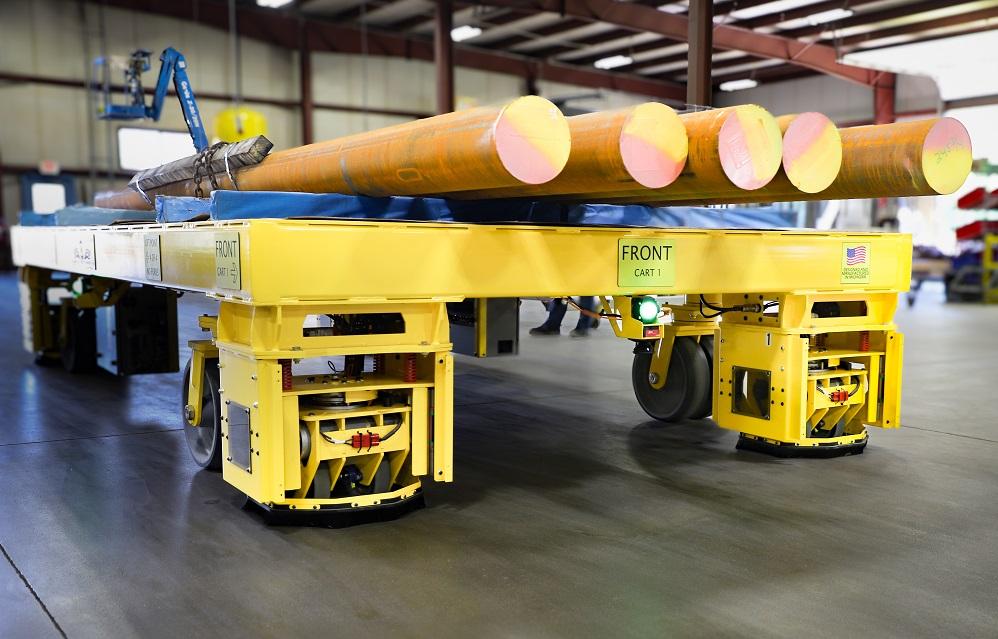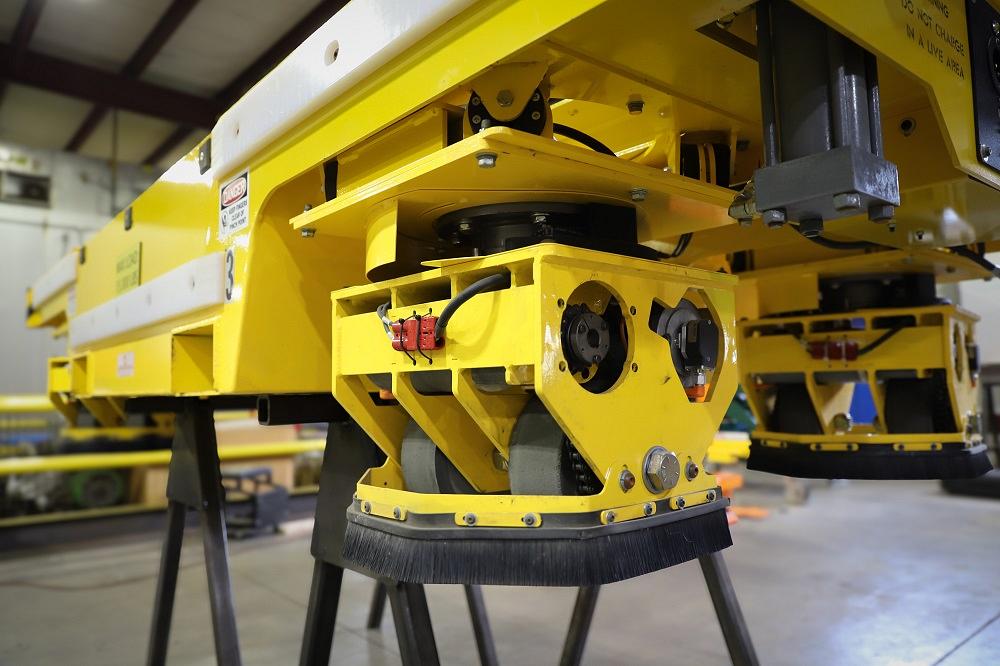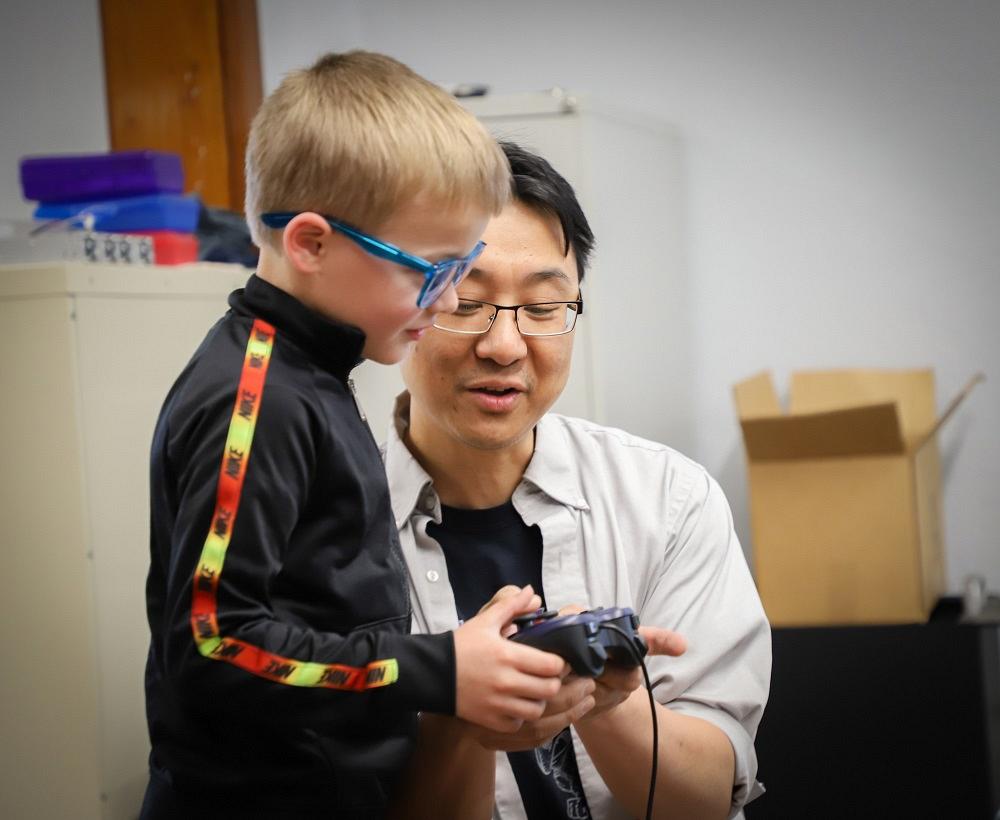Senior Editor
- FMA
- The Fabricator
- FABTECH
- Canadian Metalworking
Categories
- Additive Manufacturing
- Aluminum Welding
- Arc Welding
- Assembly and Joining
- Automation and Robotics
- Bending and Forming
- Consumables
- Cutting and Weld Prep
- Electric Vehicles
- En Español
- Finishing
- Hydroforming
- Laser Cutting
- Laser Welding
- Machining
- Manufacturing Software
- Materials Handling
- Metals/Materials
- Oxyfuel Cutting
- Plasma Cutting
- Power Tools
- Punching and Other Holemaking
- Roll Forming
- Safety
- Sawing
- Shearing
- Shop Management
- Testing and Measuring
- Tube and Pipe Fabrication
- Tube and Pipe Production
- Waterjet Cutting
Industry Directory
Webcasts
Podcasts
FAB 40
Advertise
Subscribe
Account Login
Search
Manufacturing’s massive side of material handling
Michigan-based Conceptual Innovations engineers ways to move heavy plate and large structures
- By Tim Heston
- April 4, 2024
- Article
- Materials Handling

A motorized cart transports thick barstock from one side of the plant to the other. Images: Conceptual Innovations
Imagine a highly automated precision sheet metal factory, with laser-cut material moved not with fork trucks but with a highly choreographed army of autonomous mobile robots (AMRs) or automated guided vehicles. The sheet metal sector has eye-opening potential for some truly autonomous material handling.
But what about heavy plate or structures fabricated to a massive scale? Working on and moving them can be extraordinarily arduous, introduce a host of hazards, and constrain operational flow in a serious way. The pain might not always be obvious. Work center cycle times in heavy, large-scale manufacturing and fabrication shops can last days or weeks, not minutes or hours. Nevertheless, the efficiency drain and safety hazards are very real.
Elmer Lee, PhD, knows this all too well. The engineer at Albion, Mich.-based Conceptual Innovations—who, as head of exploration, has what may be the industry’s best job title—leads a small team that tackles some big material handling challenges, literally and metaphorically. Well-known aerospace, defense, and (very) heavy equipment OEMs have turned to them to help move loads measured in the thousands of pounds, even tons.
A subsidiary of Caster Concepts, Conceptual Innovations likely would never have grown into what it is today if it weren’t for several key events. Available manufacturing capacity—which includes laser cutting, bending, and welding—gave the organization a runway to launch highly engineered-to-order products. Perhaps most important, the organization gives people capacity to think.
“The truth is, I was bored,” Lee said, thinking back to the events of the mid-2000s that led to Conceptual Innovations’ formation. “We had the manufacturing horsepower. Now, what could we build?”
Boredom Is Undervalued
In the early 2010s, Lee led a team of Caster Concepts engineers hired to build equipment to test the robustness of caster designs. Casters are utterly ubiquitous and often taken for granted. But for manufacturers, and metal fabricators in particular, a well-designed caster system can make a world of difference for material flow.
Good casters integrated with ergonomic carts can reduce a fabricator’s reliance on fork trucks. They can help reduce batch sizes and, in turn, the level of work-in-process between operations. Instead of relying on a fork truck to move a pallet stacked high with parts, people can drip-feed smaller batches or even kits. Walk the floor of any custom fabricator today, and you’ll likely see ergonomic carts stationed next to press brakes, deburring machines, hardware insertion presses, and welding cells. The caster keeps everything on the move.
Lean, predictable workflow has hidden benefits—and the story behind Conceptual Innovations’ founding is a prime example. In the early 2000s, Caster Concepts operated with a traditional, make-to-stock model that really didn’t suit its high product mix. The company never focused on commodity casters, like the kind found on grocery carts. It instead served customers in more demanding commercial and industrial sectors, those for whom a bad or broken caster isn’t a mere inconvenience. The business model demanded a massive product catalog, which in turn led managers to scrutinize and perfect their demand forecasting. After all, without a good sales forecast, manufacturing wouldn’t know what they needed to make to stock. And without the right products in stock, the company wouldn’t have anything to sell—right?
Unfortunately, the sales forecast rarely reflected reality. Manufacturing nearly always spent too much time fabricating and machining parts that would end up sitting on shelves for months or even years. All too often, those operating the company’s machinery—be it in laser cutting, bending, or machining departments—received rush orders for unexpected jobs that they had to squeeze into an already overwhelmed production environment.
In 2008 and 2009, the company switched gears and completely revamped its manufacturing process. Adopting a methodology called quick-response manufacturing, or QRM, it stopped producing parts to stock and reorganized work centers into multiprocess cells. Today, the operation produces parts that meet actual, not predicted, demand. Everything made in-house is fabricated from scratch after an order is placed.

The omnidirectional HaloDrive is installed on a powered cart designed for heavy-duty material handling applications.
Lee was initially hired in the early 2000s to ramp up Caster Concepts’ testing lab. He has a PhD in mechanical engineering, but his career took him toward manufacturing process development, automation, and robotics. Leading the lab, he developed dynamo systems, tying various motors and sensors together, developing programs that could stress-test the company’s new caster offerings. As Lee put it, “We were basically breaking things in a quantifiable way.”
In 2008, around the same time QRM was ramping up within the larger organization, Lee began, true to his current job title, exploring. His mind wandered and, yes, he was a bit bored. That, as it turned out, wasn’t a bad thing.
Driven Casters
The testing lab team was already experienced in building custom equipment, integrating servomotors and electrical assemblies. Moreover, work with existing customers gave engineers a clue into an underserved niche of the material handling market: highly customized and extremely heavy-duty applications. The company’s existing customer base expressed a need, and QRM could help them meet it quickly—a benefit the organization especially began to realize in the early 2010s. There was no need to outsource metal fabrication, machining, or powder coating. Orders for customized powered carts could be integrated into material flow, just like any other job. The building blocks for Conceptual Innovations were in place.
One early project involved a tractor assembly plant in Wisconsin. “Our concept entailed a powered cart that would move a 3,000-lb. transmission casing to allow them to assemble different gears into that housing,” Lee said. “They had previously used an overhead crane to lift and reorient the casing, and that presented some potential safety hazards. They didn’t want a 3,000-lb. mass swinging around.”
Lee first considered outsourcing the drive system development. After all, Caster Concepts knew casters, machining, and metal fabrication, but developing specialized drive systems really wasn’t in its wheelhouse, so to speak.
“We thought we’d be building a frame on top of a drive system,” Lee said, “but there really is no one in North America that could sell us the kind we needed. We could purchase motors and electronics, and we could of course build the wheels, but no one would marry it all together. So we had to do it ourselves. That’s what set us down our current path.”
These early projects incorporated a single-drive caster system. A simple motor connected to a drive wheel that went forward and backward. Integrate two of them into a cart or platform, and you got a tank-steer system. When drive wheels on both sides rotate the same direction, the cart goes forward or backward. When they rotate in opposite directions, the cart rotates right or left, just how a tank steers on the battlefield.
Enter the Next Generation
The company’s next generation of drive wheels came from, well, the next generation—specifically, the students participating in Albion’s extremely active FIRST Robotics team. Think BattleBots without the violence. Teams compete to develop robots that score goals on a court and in the process learn to innovate with drives, motors, circuit boards, and other building blocks of electrical engineering and automation. For years, Lee had coached Albion’s FIRST team, and Caster Concepts has been instrumental in helping the team grow. The company launched INNOVATE Albion, an organization that provides STEM education and supports FIRST Robotics teams. The idea is to teach kids to innovate, and innovate they do. In fact, Conceptual Innovations likely wouldn’t be where it is today without its connection to FIRST Robotics.
“I was coaching the high school team, and at that point, we were developing an omnidirectional drive for the team’s robot,” Lee said, adding that, as it turned out, representatives from an aerospace manufacturer witnessed the team in action and saw the drive system they were developing. “They asked, ‘What is that? Can you put that on some of our equipment?’”
At that point, the aerospace manufacturer’s assembly plant was using large workstands that had to be moved manually, either by hand (requiring a half-dozen people or more) or fork truck. Starting with that FIRST Robotics encounter, the Conceptual Innovations team developed the company’s first industrial-grade omnidirectional drive system, one that could (as the name implies) move in all directions without needing to rotate the load it’s carrying.

Elmer Lee of Conceptual Innovations works with a student at INNOVATE Albion, a STEM learning center in Albion, Mich.
The product has evolved significantly and is now sold under the HaloDrive brand. The ring above the drive system looks like a halo, hence the brand name. That ring also happens to incorporate similar swivel bearings as Caster Concepts uses in its caster products.
Who Needs a Crane?
The battery-powered material handling systems Conceptual makes might look like AMRs, but they really aren’t. They do require battery charging strategies, like AMR fleets do. And they do have semi-autonomous aspects, especially when it comes to local scanning for safety, ensuring the units stop if someone or something gets too close. Lee’s team will be taking steps to advance the technology toward autonomous operation, but at this point the systems don’t run on their own. Someone must operate them with a wireless control pendant.
If an application involves work that moves in intervals measured in minutes, AMRs can make perfect sense. Again, imagine an army of AMRs taking small batches of cut or formed sheet metal parts from one station to the next. But what if one large part needs to move every few hours or (for the heaviest work) days? Here, safety and ceiling height can cause issues, as can tying up a shared resource like a massive overhead crane. Material handling factors can vary considerably from one huge workpiece to the next, and the cost of error can be extremely high. Dropping or misplacing a small sheet metal blank is one thing; damaging a 40,000-lb. assembly is something else entirely. Building an autonomous system to accommodate all these elements really isn’t practical, at least for now.
In general, the fewer times a large workpiece needs to be moved, the better. So, many times, manufacturers choose to keep the workpiece on the powered cart, which can drive and position its load through multiple workstations along the value stream—eliminating crane use entirely. The approach has a downside, though. Cycle times at each station can be long, and for all that time, the cart isn’t available to move something else.
When a cart can move and lift, the story changes. Lee described one application in which Conceptual engineers designed a lift-and-carry powered cart. Here, work is placed on racks that have clearance for a powered cart to travel underneath. With pendant in hand, the operator drives the cart underneath the rack, then engages the cart’s hydraulics to lift the workpiece. From there, the cart carries the assembly to the next workstation, lowers itself to gently place its payload on another rack support, then moves elsewhere as needed. This approach both eliminates the need for a crane and makes better use of the mobile carts.
This doesn’t work for every application, of course. In these cases, Conceptual engineers work to minimize, rather than eliminate, crane usage. Lee described one defense industry application where a 40,000-lb. workpiece had to be moved between two welding stations spaced far apart on the factory floor. The two welding processes couldn’t be combined into one station, and they couldn’t be moved closer together either. So, production team members relied on a crane until they could find a better option.
Integrating powered carts introduced another option. Crane operators still needed to pick the large pieces from the cart to the weld fixtures at each station, but these crane picks took just a fraction of the time.
Put another way, cranes did the heavy lifting while the powered carts did the transporting—and everything is designed with safety and low center of gravity in mind. Moreover, at least some welding could be completed while the work sat on the powered carts. This in turn reduced cycle time at each of those far-apart weld cells.
With no more massive workpieces hung on a crane and carried across the plant, the application became a lot safer. As Lee described, some manufacturers now use powered carts to move large workpieces even during busy shifts. Before, to ensure safety, crane operators would do their picks during third shift or other times when the floor was sparsely populated.
Positioning Accuracy
When the positioning accuracy isn’t extreme, a machine or person can simply work on the product as the powered cart presents it. When accuracy is critical, an operation might choose to lift the workpiece from the cart and place it on a dedicated precision fixture. Other times, operations take extra steps to increase positioning accuracy.
Lee described one material handling application involving the inspection of a large rocket section. “In this case, the carts could do the macro-positioning. They got the work within a ¼ in. Then, [the manufacturer] put a gantry robot on our cart that could home itself.” This established exactly where the rocket section was on the cart to within the tolerance the inspection process required.
Manufacturing Platform for Innovation
Since its incorporation in 2008, Conceptual has worked with some heavy industrial hitters, including major aerospace and defense contractors, national labs, even NASA. Lee attributes the company’s success to several factors. One again has to do with quick response without relying on inventory.
“We don’t stock 50 HaloDrives on a shelf waiting for a customer to order them. We have a design, based on load, speed, and performance, and the order immediately goes into laser cutting, welding, powder coating, and assembly. We also designed the entire system with very few machined items. This was on purpose.”
Lasers can cut sheet metal and plate in minutes; mills and lathes take longer and, hence, add significant time and cost.
Another factor, and perhaps the keystone to it all, is technical talent—hence the importance of FIRST Robotics and INNOVATE Albion. Without creative engineers, Conceptual really wouldn’t exist. “We knew we needed to grow our own talent base,” Lee said, describing how Caster and Conceptual offer scholarships, internships, sponsorships, and—most recently—space to innovate.
In 2019, the company purchased a building for INNOVATE Albion programs to hold teaching sessions and labs. It also has space for FIRST Robotics students to build and test their creations.
“Our involvement with INNOVATE Albion and FIRST Robotics is helping us build a pipeline for engineering talent. We have nine engineers [at Conceptual] now, and two of them came through those educational and internship programs.”
The entire organization has come a long way since its headache-inducing build-to-stock days. Highly capable, responsive metal fabrication and manufacturing provide the foundation. That controlled environment gave people time to think and innovate. Finally, those school and community partnerships build the talent pipeline.
Consider again the story of Conceptual Innovations’ founding. Lee was bored, and he was given the freedom to think and act. Being bored, in retrospect, ended up being extraordinarily productive.
About the Author

Tim Heston
2135 Point Blvd
Elgin, IL 60123
815-381-1314
Tim Heston, The Fabricator's senior editor, has covered the metal fabrication industry since 1998, starting his career at the American Welding Society's Welding Journal. Since then he has covered the full range of metal fabrication processes, from stamping, bending, and cutting to grinding and polishing. He joined The Fabricator's staff in October 2007.
Related Companies
subscribe now

The Fabricator is North America's leading magazine for the metal forming and fabricating industry. The magazine delivers the news, technical articles, and case histories that enable fabricators to do their jobs more efficiently. The Fabricator has served the industry since 1970.
start your free subscription- Stay connected from anywhere

Easily access valuable industry resources now with full access to the digital edition of The Fabricator.

Easily access valuable industry resources now with full access to the digital edition of The Welder.

Easily access valuable industry resources now with full access to the digital edition of The Tube and Pipe Journal.
- Podcasting
- Podcast:
- The Fabricator Podcast
- Published:
- 04/16/2024
- Running Time:
- 63:29
In this episode of The Fabricator Podcast, Caleb Chamberlain, co-founder and CEO of OSH Cut, discusses his company’s...
- Trending Articles
Tips for creating sheet metal tubes with perforations

Supporting the metal fabricating industry through FMA

JM Steel triples capacity for solar energy projects at Pennsylvania facility

Fabricating favorite childhood memories

Omco Solar opens second Alabama manufacturing facility

- Industry Events
16th Annual Safety Conference
- April 30 - May 1, 2024
- Elgin,
Pipe and Tube Conference
- May 21 - 22, 2024
- Omaha, NE
World-Class Roll Forming Workshop
- June 5 - 6, 2024
- Louisville, KY
Advanced Laser Application Workshop
- June 25 - 27, 2024
- Novi, MI


























